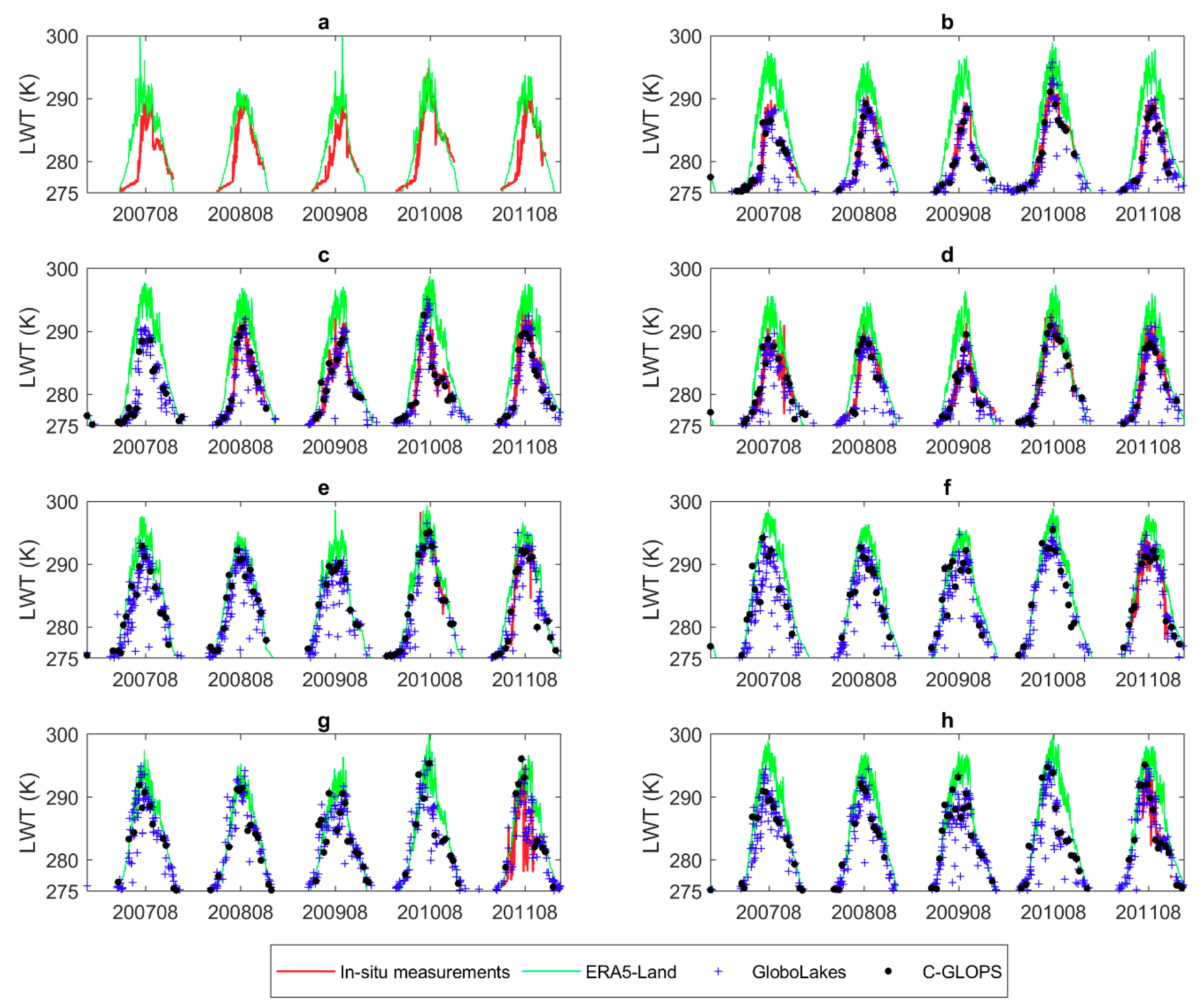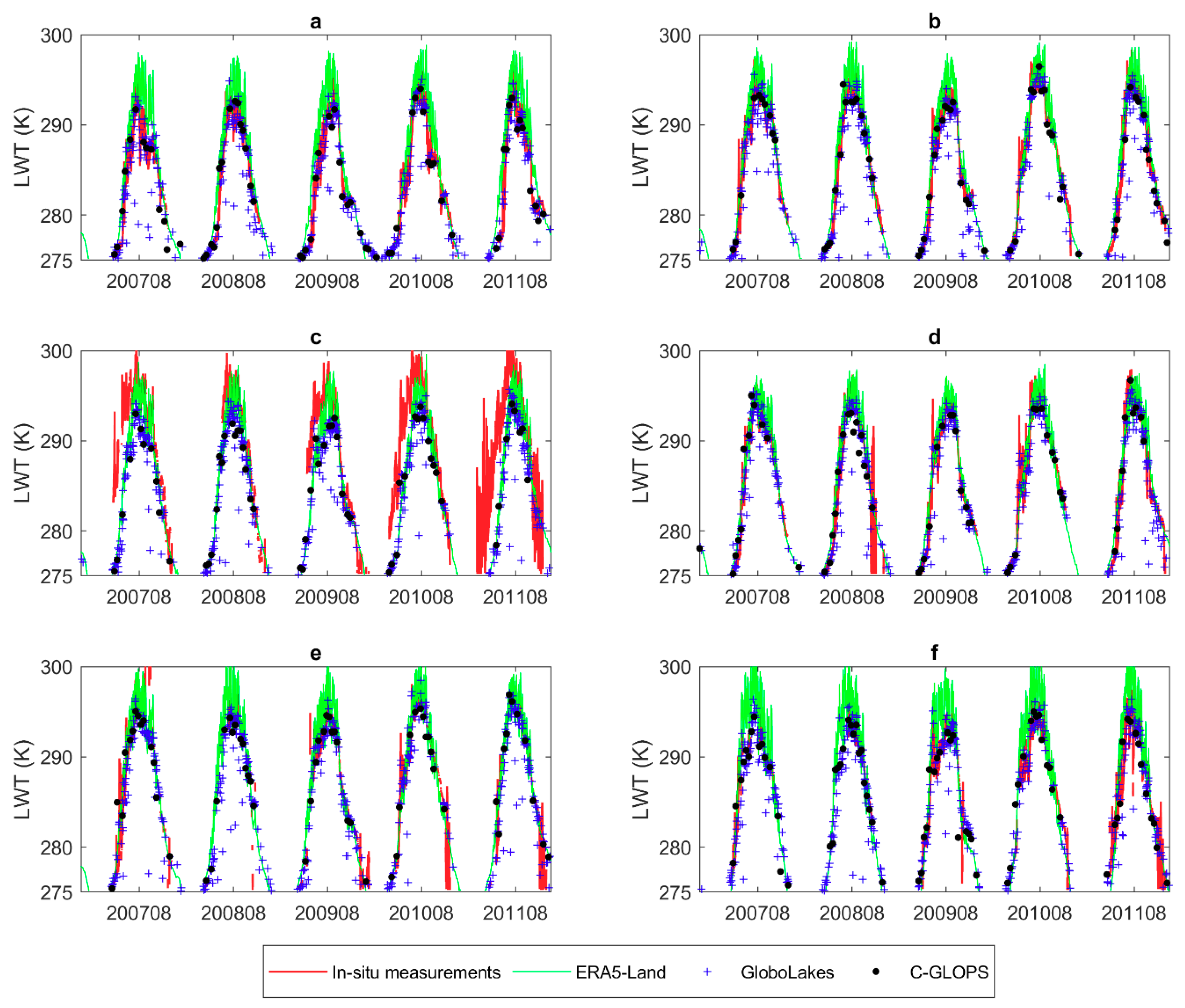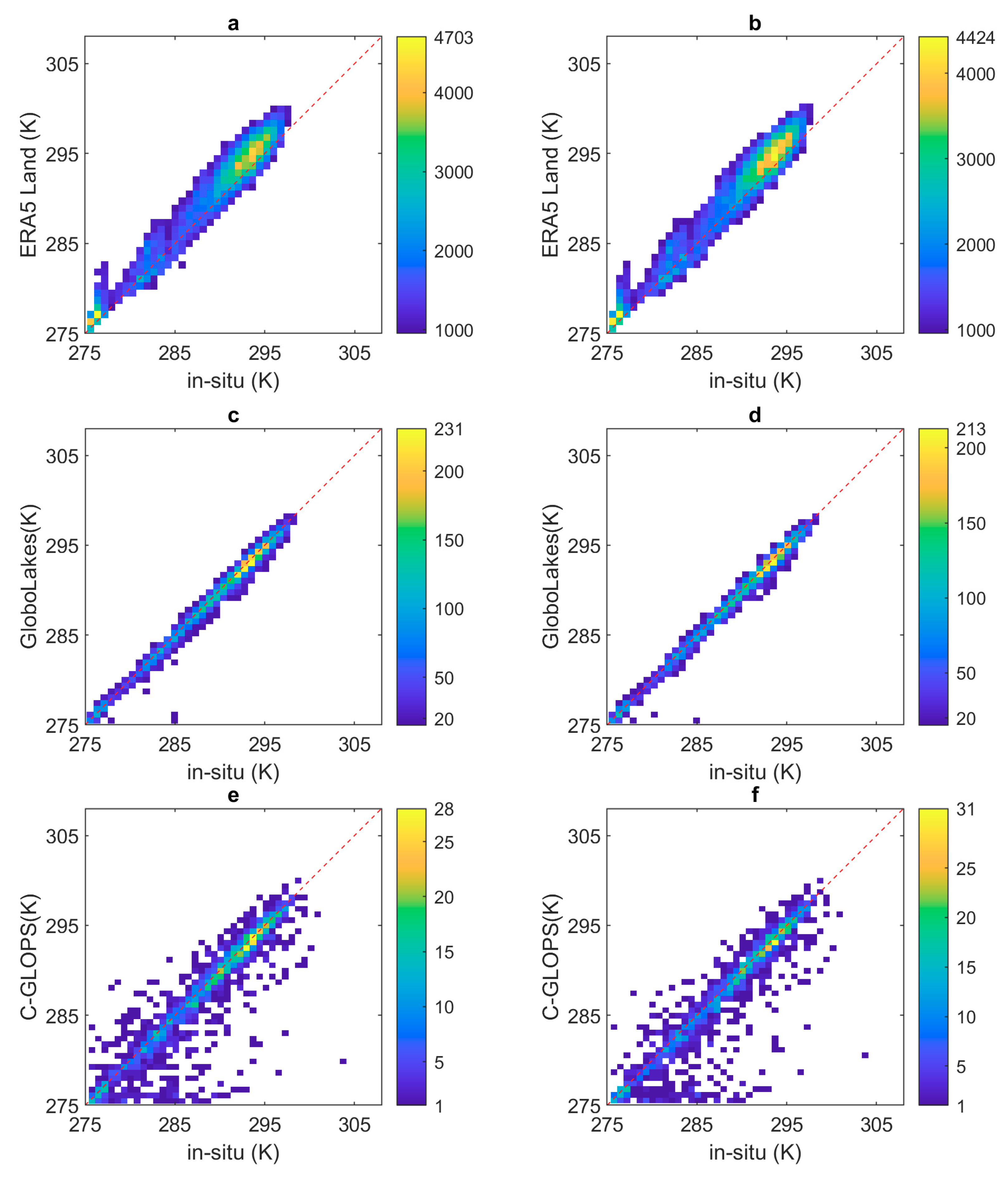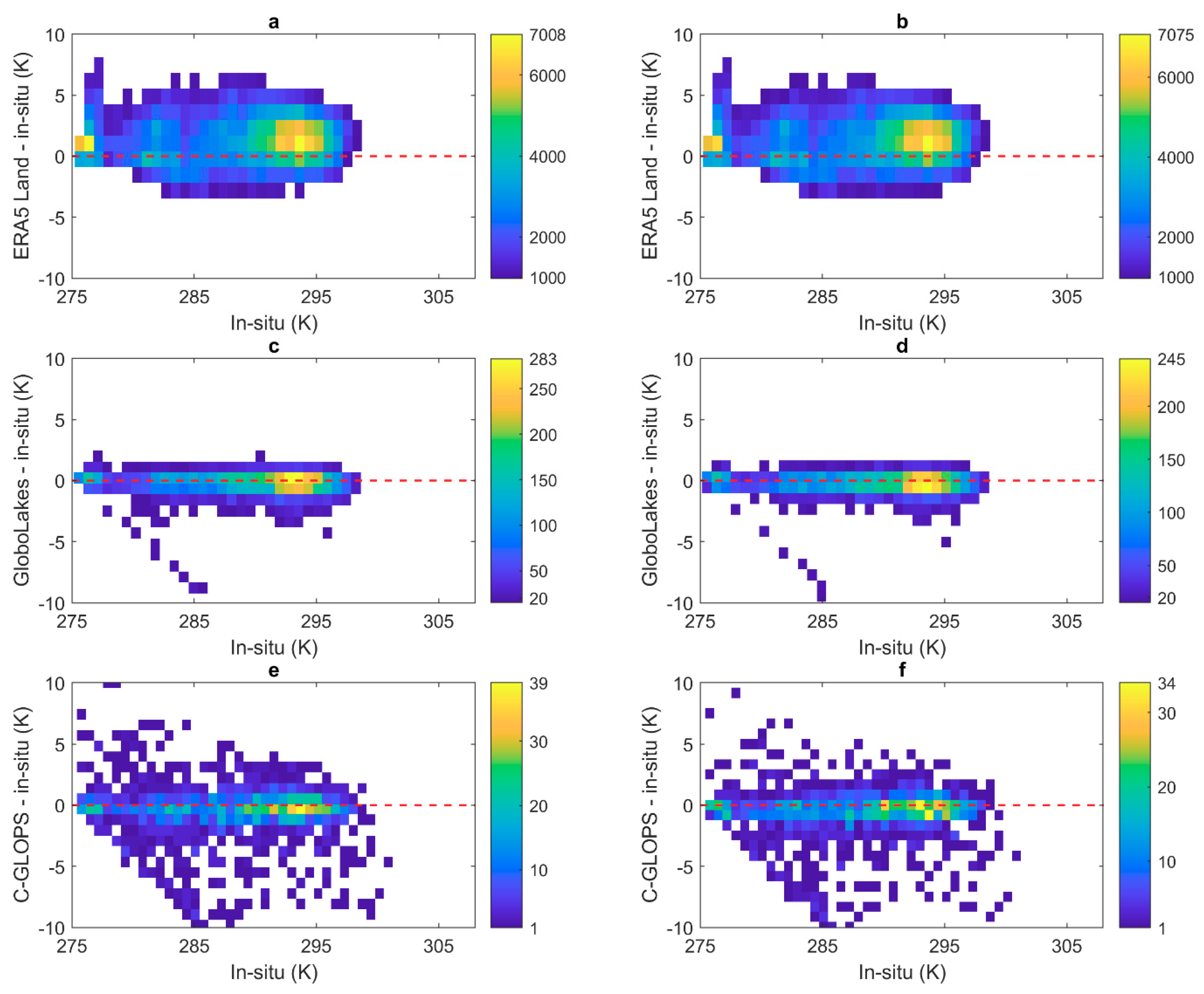Evaluation of Global Surface Water Temperature Data Sets for Use in Passive Remote Sensing of Soil Moisture
Abstract
1. Introduction
2. Study Regions and Lake Temperature Data Sets
2.1. Study Regions
2.2. Lake Temperature Data Sets
2.2.1. Global Observatory of Lake Responses to Environmental Change (GloboLakes)
2.2.2. Copernicus Global Land Operations (C-GLOPS)
2.2.3. ERA5 Land
2.2.4. In-Situ Measurements of Lake Surface Temperature
3. Methodology and Assessment Metrics
3.1. Validation against In-Situ Measurements
3.2. Inter-Comparisons among Lake Temperature Products at the 9 km Scale
3.3. Assessment Metrics
4. Results
4.1. Overall Performance of Lake Temperature Products at Their Original Resolutions
4.2. Overall Performance of Lake Temperature Products at the 9 km EASE Resolution
4.3. Matchup Intercomparison of Lake Temperature Products
5. Discussion
6. Conclusions
Author Contributions
Funding
Data Availability Statement
Acknowledgments
Conflicts of Interest
Appendix A
| Index | Name/Country | Latitude | Longitude | Start Year | Buoy | Senor Depth (Meter Below Water Line) | Organization * |
|---|---|---|---|---|---|---|---|
| 1 | Superior/Canada-USA | 48.06 | −89.79 | 1979 | 45001 | 1.1 | NDBC |
| 2 | Superior/Canada-USA | 47.59 | −86.59 | 1980 | 45004 | 1.3 | NDBC |
| 3 | Superior/Canada-USA | 47.34 | −89.79 | 1981 | 45006 | 1.3 | NDBC |
| 4 | Superior/Canada-USA | 48.54 | −86.95 | 1989 | 45136 | MTU | |
| 5 | Superior/Canada-USA | 47.27 | −88.61 | 2010 | 45023 | 3.0 | MTU |
| 6 | Superior/Canada-USA | 46.97 | −88.40 | 2011 | 45025 | 3.0 | UMD |
| 7 | Superior/Canada-USA | 46.86 | −91.93 | 2011 | 45027 | 1.0 | UMD |
| 8 | Superior/Canada-USA | 46.81 | −91.83 | 2011 | 45028 | 1.0 | NDBC |
| 9 | Huron/Canada-USA | 45.53 | −82.84 | 1980 | 45003 | 0.4 | NDBC |
| 10 | Huron/Canada-USA | 44.28 | −82.42 | 1981 | 45008 | 1.3 | ECCC |
| 11 | Huron/Canada-USA | 45.54 | −81.02 | 1989 | 45137 | ECCC | |
| 12 | Huron/Canada-USA | 44.94 | −80.63 | 1997 | 45143 | ECCC | |
| 13 | Huron/Canada-USA | 43.54 | −82.08 | 2000 | 45149 | ECCC | |
| 14 | Huron/Canada-USA | 46.05 | −82.64 | 1999 | 45154 | NDBC | |
| 15 | Michigan/USA | 45.34 | −86.41 | 1979 | 45002 | NDBC | |
| 16 | Michigan/USA | 42.67 | −87.03 | 1981 | 45007 | 1.3 | UMC |
| 17 | Michigan/USA | 45.41 | −85.09 | 2010 | 45022 | 1.0 | LT |
| 18 | Michigan/USA | 41.98 | −86.62 | 2011 | 45026 | 1.0 | ECCC |
| 19 | Great Slave/Canada | 61.18 | −115.31 | 1992 | 45141 | ECCC | |
| 20 | Great Slave/Canada | 61.98 | −144.13 | 2004 | 45150 | NDBC | |
| 21 | Erie/Canada | 41.68 | −82.40 | 1980 | 45005 | 1.6 | ECCC |
| 22 | Erie/Canada | 42.74 | −79.29 | 1994 | 45142 | ECCC | |
| 23 | Erie/Canada | 42.46 | −81.22 | 1989 | 45132 | ECCC | |
| 24 | Winnipeg/Canada | 50.80 | −96.73 | 1999 | 45140 | ECCC | |
| 25 | Winnipeg/Canada | 53.23 | −98.29 | 2004 | 45144 | ECCC | |
| 26 | Winnipeg/Canada | 51.87 | −96.97 | 2001 | 45145 | NDBC | |
| 27 | Ontario/Canada | 43.62 | −77.40 | 2002 | 45012 | 1.3 | ECCC |
| 28 | Ontario/Canada | 43.78 | −76.87 | 1989 | 45135 | ECCC | |
| 29 | Ontario/Canada | 43.23 | −79.53 | 1991 | 45139 | ECCC | |
| 30 | Ontario/Canada | 43.77 | −78.98 | 2009 | 45159 | ECCC | |
| 31 | Woods/Canada | 49.64 | −94.50 | 2000 | 45148 | ECCC | |
| 32 | Saint Clair/Canada | 42.43 | −82.68 | 2000 | 45147 | ECCC | |
| 33 | Nipissing/Canada | 46.23 | −79.72 | 1999 | 45152 | ECCC | |
| 34 | Simcoe/Canada | 44.50 | −79.37 | 1999 | 45151 | ECCC |
References
- Koster, R.D.; Dirmeyer, P.A.; Guo, Z.; Bonan, G.; Chan, E.; Cox, P.; Gordon, C.; Kanae, S.; Kowalczyk, E.; Lawrence, D. Regions of strong coupling between soil moisture and precipitation. Science 2004, 305, 1138–1140. [Google Scholar] [CrossRef] [PubMed]
- Dai, A.; Trenberth, K.E.; Qian, T. A global dataset of Palmer Drought Severity Index for 1870–2002: Relationship with soil moisture and effects of surface warming. J. Hydrometeorol. 2004, 5, 1117–1130. [Google Scholar] [CrossRef]
- Entekhabi, D.; Njoku, E.G.; O’Neill, P.E.; Kellogg, K.H.; Crow, W.T.; Edelstein, W.N.; Entin, J.K.; Goodman, S.D.; Jackson, T.J.; Johnson, J. The soil moisture active passive (SMAP) mission. Proc. IEEE 2010, 98, 704–716. [Google Scholar] [CrossRef]
- Petropoulos, G. Remote Sensing of Energy Fluxes and Soil Moisture Content; CRC Press: Boca Raton, FL, USA, 2013. [Google Scholar]
- Kim, S.; Zhang, R.; Pham, H.; Sharma, A. A review of satellite-derived soil moisture and its usage for flood estimation. Remote Sens. Earth Syst. Sci. 2019, 2, 225–246. [Google Scholar] [CrossRef]
- Al-Yaari, A.; Wigneron, J.-P.; Ducharne, A.; Kerr, Y.; De Rosnay, P.; De Jeu, R.; Govind, A.; Al Bitar, A.; Albergel, C.; Munoz-Sabater, J. Global-scale evaluation of two satellite-based passive microwave soil moisture datasets (SMOS and AMSR-E) with respect to Land Data Assimilation System estimates. Remote Sens. Environ. 2014, 149, 181–195. [Google Scholar] [CrossRef]
- Lakshmi, V.; Wood, E.F.; Choudhury, B.J. A soil-canopy-atmosphere model for use in satellite microwave remote sensing. J. Geophys. Res. Atmos. 1997, 102, 6911–6927. [Google Scholar] [CrossRef]
- Njoku, E.G.; Jackson, T.J.; Lakshmi, V.; Chan, T.K.; Nghiem, S.V. Soil moisture retrieval from AMSR-E. IEEE Trans. Geosci. Remote Sens. 2003, 41, 215–229. [Google Scholar] [CrossRef]
- Kerr, Y.H.; Waldteufel, P.; Wigneron, J.-P.; Delwart, S.; Cabot, F.; Boutin, J.; Escorihuela, M.-J.; Font, J.; Reul, N.; Gruhier, C. The SMOS mission: New tool for monitoring key elements ofthe global water cycle. Proc. IEEE 2010, 98, 666–687. [Google Scholar] [CrossRef]
- Fang, B.; Lakshmi, V.; Bindlish, R.; Jackson, T.J.; Cosh, M.; Basara, J. Passive microwave soil moisture downscaling using vegetation index and skin surface temperature. Vadose Zone J. 2013, 12, 1–19. [Google Scholar] [CrossRef]
- Fang, B.; Lakshmi, V.; Bindlish, R.; Jackson, T.J. Downscaling of SMAP soil moisture using land surface temperature and vegetation data. Vadose Zone J. 2018, 17, 1–15. [Google Scholar] [CrossRef]
- Fang, B.; Lakshmi, V.; Bindlish, R.; Jackson, T.J.; Liu, P.-W. Evaluation and validation of a high spatial resolution satellite soil moisture product over the Continental United States. J. Hydrol. 2020, 588, 125043. [Google Scholar] [CrossRef]
- Fang, B.; Lakshmi, V.; Cosh, M.; Hain, C. Very High Spatial Resolution Downscaled SMAP Radiometer Soil Moisture in the CONUS using VIIRS/MODIS data. J. Sel. Top. J. Appl. Earth Obs. Remote Sens. 2021, in press. [Google Scholar] [CrossRef]
- O’Neill, P.; Bindlish, R.; Chan, S.; Njoku, E.; Jackson, T. Algorithm Theoretical Basis Document. Level 2 & 3 Soil Moisture (Passive) Data Products. 2018. Available online: https://nsidc.org/sites/nsidc.org/files/technical-references/L2_SM_P_ATBD_rev_D_Jun2018_auto_TOC.pdf (accessed on 9 May 2021).
- Kerr, Y.H.; Waldteufel, P.; Richaume, P.; Wigneron, J.P.; Ferrazzoli, P.; Mahmoodi, A.; Al Bitar, A.; Cabot, F.; Gruhier, C.; Juglea, S.E. The SMOS soil moisture retrieval algorithm. IEEE Trans. Geosci. Remote Sens. 2012, 50, 1384–1403. [Google Scholar] [CrossRef]
- Fernandez-Moran, R.; Wigneron, J.-P.; De Lannoy, G.; Lopez-Baeza, E.; Parrens, M.; Mialon, A.; Mahmoodi, A.; Al-Yaari, A.; Bircher, S.; Al Bitar, A. A new calibration of the effective scattering albedo and soil roughness parameters in the SMOS SM retrieval algorithm. Int. J. Appl. Earth Obs. Geoinf. 2017, 62, 27–38. [Google Scholar] [CrossRef]
- Carrea, L.; Merchant, C. GloboLakes: Lake Surface Water Temperature (LSWT) v4.0 (1995–2016). Cent. Environ. Data Anal. 2019. [Google Scholar] [CrossRef]
- Sabater, J.M. ERA5-Land hourly data from 1981 to present. Copernic. Clim. Chang. Serv. (C3S) Clim. Data Store (CDS) 2019. [Google Scholar] [CrossRef]
- Carrea, L.; Merchant, C. Copernicus Global Land Operations Cryosphere and Water C-GLOPS2 Framework Service Contract N 199496 (JRC) Product User Manual LAKE SURFACE WATER TEMPERATURE 1KM PRODUCTS. 2020. Available online: https://land.copernicus.eu/global/sites/cgls.vito.be/files/products/CGLOPS_PUM_LSWT_1km_v1.0.1_I1.09.pdf (accessed on 9 May 2021).
- Muñoz-Sabater, J.; Dutra, E.; Agustí-Panareda, A.; Albergel, C.; Arduini, G.; Balsamo, G.; Boussetta, S.; Choulga, M.; Harrigan, S.; Hersbach, H. ERA5-Land: A state-of-the-art global reanalysis dataset for land applications. Earth Syst. Sci. Data Discuss. 2021, 1–50. [Google Scholar]
- MacCallum, S.N.; Merchant, C.J. Surface water temperature observations of large lakes by optimal estimation. Can. J. Remote Sens. 2012, 38, 25–45. [Google Scholar] [CrossRef]
- Carrea, L.; Merchant, C. Copernicus Global Land Operations Cryosphere and Water C-GLOPS2 Framework Service Contract N 199496 (JRC) ALGORIHM THEORETICAL BASIS DOCUMENT LAKE SURFACE WATER TEMPERATURE 1 KM PRODUCTS. 2020. Available online: https://land.copernicus.eu/global/sites/cgls.vito.be/files/products/CGLOPS_ATBD_LSWT_1km_v1.0.1_I1.09.pdf (accessed on 9 May 2021).
- O’Reilly, C.M.; Sharma, S.; Gray, D.K.; Hampton, S.E.; Read, J.S.; Rowley, R.J.; Schneider, P.; Lenters, J.D.; McIntyre, P.B.; Kraemer, B.M. Rapid and highly variable warming of lake surface waters around the globe. Geophys. Res. Lett. 2015, 42, 10773–10781. [Google Scholar] [CrossRef]
- Layden, A.; Merchant, C.; MacCallum, S. Global climatology of surface water temperatures of large lakes by remote sensing. Int. J. Climatol. 2015, 35, 4464–4479. [Google Scholar] [CrossRef]
- Wan, W.; Li, H.; Xie, H.; Hong, Y.; Long, D.; Zhao, L.; Han, Z.; Cui, Y.; Liu, B.; Wang, C. A comprehensive data set of lake surface water temperature over the Tibetan Plateau derived from MODIS LST products 2001–2015. Sci. Data 2017, 4, 1–10. [Google Scholar] [CrossRef]
- Carrea, L.; Merchant, C. Copernicus Global Land Operations Cryosphere and Water C-GLOPS Framework Service Contract N 199496 (JRC) QUALITY ASSESSMENT REPORT LAKE SURFACE WATER TEMPERATURE 1KM PRODUCTS. 2020. Available online: https://land.copernicus.eu/global/sites/cgls.vito.be/files/products/CGLOPS_QAR_LSWT_1km_v1.0.1_I1.09.pdf (accessed on 9 May 2021).
- Crosman, E.T.; Horel, J.D. MODIS-derived surface temperature of the Great Salt Lake. Remote Sens. Environ. 2009, 113, 73–81. [Google Scholar] [CrossRef]
- Lieberherr, G.; Wunderle, S. Lake surface water temperature derived from 35 years of AVHRR sensor data for European lakes. Remote Sens. 2018, 10, 990. [Google Scholar] [CrossRef]
- Schaeffer, B.A.; Iiames, J.; Dwyer, J.; Urquhart, E.; Salls, W.; Rover, J.; Seegers, B. An initial validation of Landsat 5 and 7 derived surface water temperature for US lakes, reservoirs, and estuaries. Int. J. Remote Sens. 2018, 39, 7789–7805. [Google Scholar] [CrossRef]
- Woolway, R.I.; Merchant, C.J. Worldwide alteration of lake mixing regimes in response to climate change. Nat. Geosci. 2019, 12, 271–276. [Google Scholar] [CrossRef]
- Maberly, S.C.; O’Donnell, R.A.; Woolway, R.I.; Cutler, M.E.; Gong, M.; Jones, I.D.; Merchant, C.J.; Miller, C.A.; Politi, E.; Scott, E.M. Global lake thermal regions shift under climate change. Nat. Commun. 2020, 11, 1–9. [Google Scholar] [CrossRef]
- Zhao, G.; Gao, H.; Cai, X. Estimating lake temperature profile and evaporation losses by leveraging MODIS LST data. Remote Sens. Environ. 2020, 251, 112104. [Google Scholar] [CrossRef]
- Sharma, S.; Gray, D.K.; Read, J.S.; O’reilly, C.M.; Schneider, P.; Qudrat, A.; Gries, C.; Stefanoff, S.; Hampton, S.E.; Hook, S. A global database of lake surface temperatures collected by in situ and satellite methods from 1985–2009. Sci. Data 2015, 2, 1–19. [Google Scholar] [CrossRef]
- Samuelsson, P.; Kourzeneva, E.; Mironov, D. The impact of lakes on the European climate as simulated by a regional climate model. Boreal Environ. Res. 2010, 15, 113–129. [Google Scholar]
- Brodzik, M.J.; Billingsley, B.; Haran, T.; Raup, B.; Savoie, M.H. EASE-Grid 2.0: Incremental but Significant Improvements for Earth-Gridded Data Sets. Isprs Int. J. Geo-Inf. 2012, 1, 32–45. [Google Scholar] [CrossRef]
- USEPA. Great Lakes. Available online: https://web.archive.org/web/20120529233616/http://www.epa.gov/glnpo/physfacts.html (accessed on 20 April 2021).
- USEPA. Facts and Figures about the Great Lakes. Available online: https://www.epa.gov/greatlakes/facts-and-figures-about-great-lakes (accessed on 20 April 2021).
- Politi, E.; MacCallum, S.; Cutler, M.; Merchant, C.; Rowan, J.; Dawson, T. Selection of a network of large lakes and reservoirs suitable for global environmental change analysis using Earth Observation. Int. J. Remote Sens. 2016, 37, 3042–3060. [Google Scholar] [CrossRef]
- Carrea, L.; Embury, O.; Merchant, C.J. Datasets related to in-land water for limnology and remote sensing applications: Distance-to-land, distance-to-water, water-body identifier and lake-centre co-ordinates. Geosci. Data J. 2015, 2, 83–97. [Google Scholar] [CrossRef]
- IFS Documentation CY45R1—Part IV: Physical processes. In IFS Documentation CY45R1; IFS Documentation; ECMWF: Reading, UK, 2018.
- Mironov, D. Parameterization of Lakes in Numerical Weather Prediction. Description of a Lake Model. In COSMO Technical Report; Deutscher Wetterdienst: Offenbach am Main, Germany, 2008; p. 44. [Google Scholar]
- Mironov, D.; Heise, E.; Kourzeneva, E.; Ritter, B.; Schneider, N.; Terzhevik, A. Implementation of the lake parameterisation scheme FLake into the numerical weather prediction model COSMO. Boreal Environ. Res. 2010, 15, 218–230. [Google Scholar]
- Manrique-Suñén, A.; Nordbo, A.; Balsamo, G.; Beljaars, A.; Mammarella, I. Representing land surface heterogeneity: Offline analysis of the tiling method. J. Hydrometeorol. 2013, 14, 850–867. [Google Scholar] [CrossRef]
- Hogg, R.V.; Tanis, E.A.; Zimmerman, D.L. Probability and Statistical Inference, 9th ed.; Pearson/Prentice Hall: Upper Saddle River, NJ, USA, 2010. [Google Scholar]
- Pallant, J. Survival Manual. A Step by Step Guide to Data Analysis Using SPSS for Windows, 3rd ed.; Open University Press: Berkshire, UK, 2011. [Google Scholar]
- Woodrow, L. Writing about T-Tests. Writing about Quantitative Research in Applied Linguistics; Springer Nature, Palgrave Macmillan: London, UK, 2014; pp. 63–72. [Google Scholar]










| Datasets | GloboLakes | C-GLOPS | ERA5 Land |
|---|---|---|---|
| Variable | LSWT | LSWT | LMLT |
| Spatial Coverage | 991 inland waters | 1018 inland waters | Global inland water bodies and coastal waters |
| Spatial Resolution | 0.05° × 0.05° | 1 km × 1 km | 0.1° × 0.1° |
| Temporal Coverage | June 1995–December 2016 | May 2002–March 2012; June 2016–present | January 1981 to present |
| Temporal Resolution | Daily | 10-day interval | Hourly |
| Resolution | Native Resolution | 9 km EASE Grid | ||||||||||
|---|---|---|---|---|---|---|---|---|---|---|---|---|
| Data sets/Metrics | Median Bias | RSD | Mean Bias | STD * | RMSE | R | Median Bias | RSD | Mean Bias | STD * | RMSE | R |
| ERA5 Land | 1.56 | 2.76 | 1.64 | 2.76 | 3.41 | 0.88 | 1.36 | 2.68 | 1.40 | 2.68 | 3.34 | 0.89 |
| GloboLakes | −0.27 | 0.86 | −0.97 | 2.77 | 2.91 | 0.88 | −0.29 | 0.83 | −0.90 | 2.82 | 2.97 | 0.88 |
| C-GLOPS | −0.31 | 0.93 | −0.60 | 2.18 | 2.33 | 0.92 | −0.36 | 0.92 | −0.69 | 2.15 | 2.24 | 0.94 |
| Datasets | ERA5 Land | GloboLakes | C-GLOPS |
|---|---|---|---|
| Available Pixels | 171,969 | 12,781 | 11,722 |
| Average Temporal Resolution per available pixel (day) | 1/24 | ~4 | ~26 |
| Overlapped pixels | 10,111 | ||
Publisher’s Note: MDPI stays neutral with regard to jurisdictional claims in published maps and institutional affiliations. |
© 2021 by the authors. Licensee MDPI, Basel, Switzerland. This article is an open access article distributed under the terms and conditions of the Creative Commons Attribution (CC BY) license (https://creativecommons.org/licenses/by/4.0/).
Share and Cite
Zhang, R.; Chan, S.; Bindlish, R.; Lakshmi, V. Evaluation of Global Surface Water Temperature Data Sets for Use in Passive Remote Sensing of Soil Moisture. Remote Sens. 2021, 13, 1872. https://doi.org/10.3390/rs13101872
Zhang R, Chan S, Bindlish R, Lakshmi V. Evaluation of Global Surface Water Temperature Data Sets for Use in Passive Remote Sensing of Soil Moisture. Remote Sensing. 2021; 13(10):1872. https://doi.org/10.3390/rs13101872
Chicago/Turabian StyleZhang, Runze, Steven Chan, Rajat Bindlish, and Venkataraman Lakshmi. 2021. "Evaluation of Global Surface Water Temperature Data Sets for Use in Passive Remote Sensing of Soil Moisture" Remote Sensing 13, no. 10: 1872. https://doi.org/10.3390/rs13101872
APA StyleZhang, R., Chan, S., Bindlish, R., & Lakshmi, V. (2021). Evaluation of Global Surface Water Temperature Data Sets for Use in Passive Remote Sensing of Soil Moisture. Remote Sensing, 13(10), 1872. https://doi.org/10.3390/rs13101872






